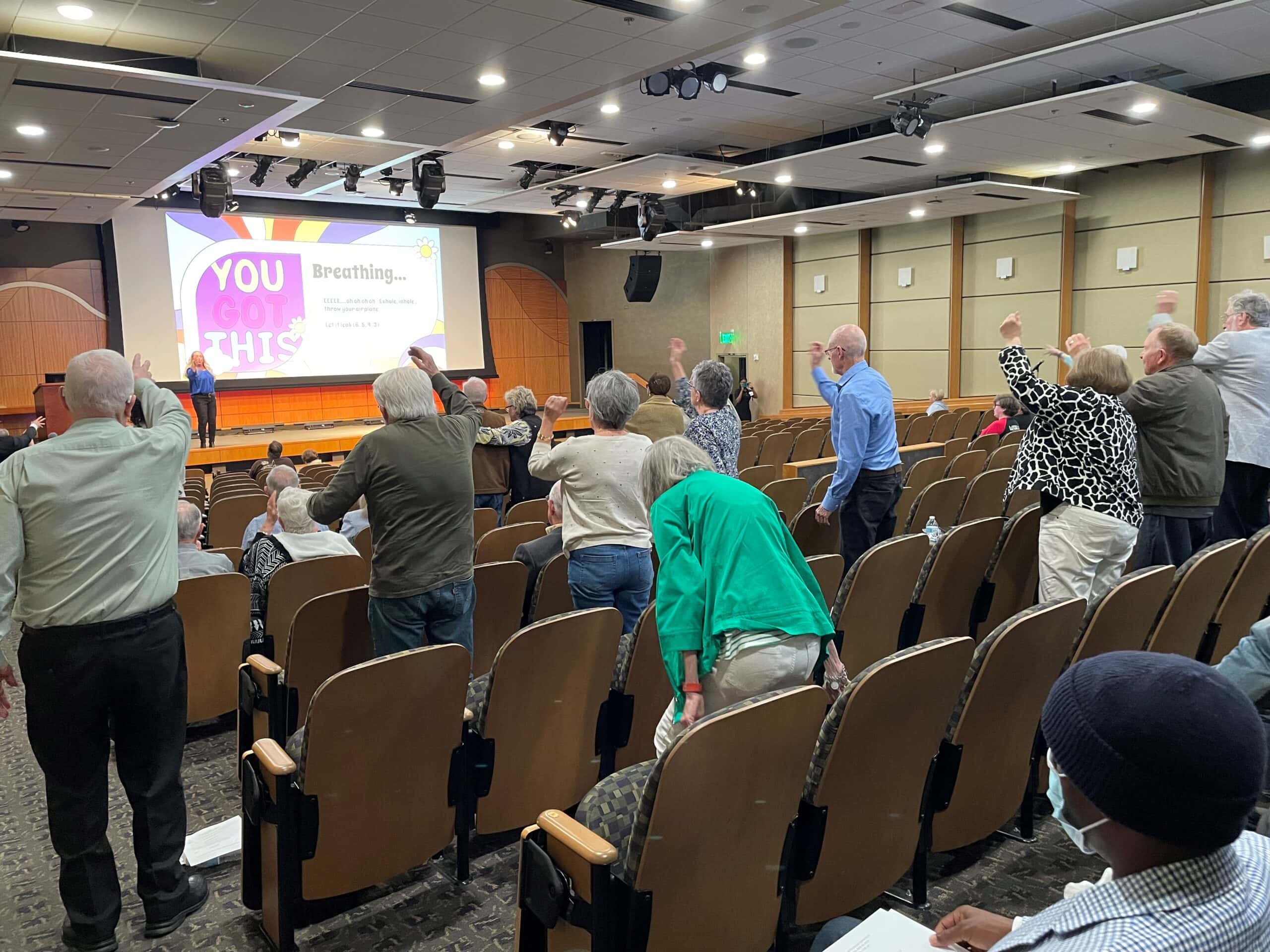Parkinson’s Patients Encouraged at Eighth Annual Symposium to Stay Active
| May 17, 2023 | The Fred Smith Auditorium at UAMS was temporarily transformed into a symphony as about 50 people attending the recent Eighth Annual Parkinson’s Symposium shook tambourines, banged hand drums, rattled percussion sticks and chimed in with musical triangles at the direction of Patty Oeste, who teaches music classes for Parkinson’s patients.
After leading the audience through warm-up breathing and brain exercises from center stage, Oeste distributed the hand-held instruments and then showed the audience how to follow video prompts aimed at each set of instruments on a large screen, which resulted in them jointly performing a rendition of Wolfgang Amadeus Mozart’s “Eine Kleine Nachtmusik (A Little Night Music).”
The lively exercise April 16 was part of the first in-person Parkinson’s symposium since 2019, after the 2020 session was canceled due to the COVID-19 outbreak and the next two annual events were limited to virtual audiences. Still others participated virtually from about 200 locations across the state.
 Before Oeste’s demonstration of some of the techniques she uses in her free workshops for Parkinson’s patients and others with neurodegenerative disorders at the UAMS Donald W. Reynolds Institute on Aging, a UAMS psychologist and a movement disorders physician provided information about cognitive changes associated with Parkinson’s disease and the importance of regular exercise to manage symptoms.
Before Oeste’s demonstration of some of the techniques she uses in her free workshops for Parkinson’s patients and others with neurodegenerative disorders at the UAMS Donald W. Reynolds Institute on Aging, a UAMS psychologist and a movement disorders physician provided information about cognitive changes associated with Parkinson’s disease and the importance of regular exercise to manage symptoms.
The annual symposium is aimed at an audience of patients, caregivers, family members, physicians and anyone else interested in learning about the progressive nervous system disorder, so the information was presented in an easy to understand format that at times had people leaning forward in their seats, eager to absorb as much information as possible.
Lee Isaac, Psy. D., an assistant professor in the UAMS Psychiatric Institute, discussed the cognitive changes that Parkinson’s patients often experience and how they can subtly sneak up on a person during routine tasks such as driving, paying bills and managing medications.
Drivers with Parkinson’s may not realize that their reaction time has slowed or that their visual-spatial abilities are compromised until a child suddenly jumps in front of their car to retrieve a ball, Isaac said. While pointing out that unsafe driving can be a side effect of the disease, he also emphasized that the multidisciplinary experts at UAMS’ Movement Disorders Clinic actually encourage patients to participate in as many activities as they can to potentially slow the disease’s progression and safely enjoy life.
“Be proactive,” he said. “Do this early.”
He recommended that all Parkinson’s patients, or anyone who suspects they have the disease, undergo an initial neuropsychological assessment at UAMS to identify their symptoms and their severity, learn “where they are” in the progression of the disease, and establish a baseline for future assessments.
“Our goal always is to maximize the benefit while minimizing the risk,” he said, emphasizing the importance of Parkinson’s patients remaining as physically, mentally and socially active as they can to slow the progression of both cognitive and physical symptoms. Among the examples he provided of steps that patients can take to lessen the severity of their symptoms were eating well, such as following the Mediterranean diet, and engaging in whatever type of cognitive stimulation the individual enjoys, such as reading or doing crossword puzzles.
“Those little day-to-day changes can pay off in the end,” he said.
Similarly, the importance of regular exercise — preferably a structured, vigorous activity but even routine household chores — to improve motor functions and sleep quality was emphasized by Aditya Vikram Boddu, M.D., an assistant professor of neurology who specializes in movement disorders.
Boddu broke down in simple terms the scientific basis for how exercise is believed to improve a patient’s physical endurance, flexibility, sleep quality, cognitive performance, mood and motor functions, while reducing the risk of falls. He recommended that Parkinson’s patients aim for 30 minutes of exercise daily, five days a week.
He said a 2021 study examined the results of 56 clinical trials involving 8,000 Parkinson’s patients in 34 countries on the type of exercise that most helps patients. He said the study concluded that there isn’t one type in particular that works for all patients, but that exercise in general improves the lives of patients, whether it be dance, pool-based exercises, mind-body exercises such as yoga and tai chi, or something else. Boddu said Parkinson’s patients do have to be cautious with certain types of exercise, such as using treadmills or elliptical exercisers, because of the potential for harming themselves inadvertently.
He encouraged patients to set exercise goals, schedule exercise at set times and figure out what works best for each of them, in order to maintain a “continuous chain link,” while remembering that “progress happens incrementally, so don’t let a bad day ruin your flow.”
The symposium also included estate planning tips from local attorney Laura Johnson and remarks from both Rohit Dhall, M.D., director of neurodegenerative disorders at UAMS, and Erika Petersen, M.D., a UAMS neurosurgeon who developed the symposium over a decade ago.
“It takes a village to manage someone with a degenerative disorder,” Dhall said, touting the multidisciplinary approach used at UAMS to ensure that each Parkinson’s patient can meet individually with the appropriate specialists at least once every year.
